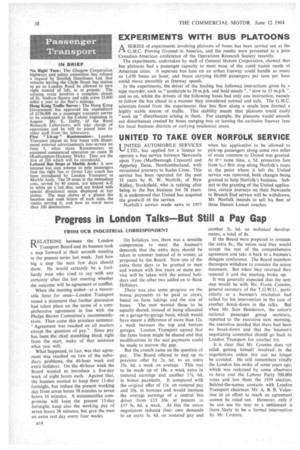EXPERIMENTS WITH BUS PLATOONS
Page 40

If you've noticed an error in this article please click here to report it so we can fix it.
ASERIES of experiments involving platoons of buses has been carried out at the G.M.C. Proving Ground in America, and the results were presented to a joint Canadian-American conference of the Operations Research Society recently.
The experiments, undertaken by staff of General Motors Corporation, showed that bus platoons had a passenger capacity to meet most of the rapid transit needs of American cities. A separate bus lane on an urban freeway could handle as many as 1,450 buses an hour, and buses carrying 60,000 passengers per lane per hour could move smoothly at freeway speeds.
In the experiments, the driver of the leading bus followed instructions given by a tape recorder, such as "accelerate to 50 m.p.h. and hold steady ", "slow to 35 m.p.h. ". and so on, whilst the drivers of the following buses had only one instruction, namely to follow the bus ahead in a manner they considered normal and safe. The G.M.C. scientists found from the experiments that bus flow along a single lane formed a highly stable stream of traffic. This stability meant that platoons could easily "soak up" disturbances arising in them. For example, the platoons would smooth out disturbances created by buses merging into or leaving the exclusive freeway lane for local business districts or outlying residential areas.
































































































































